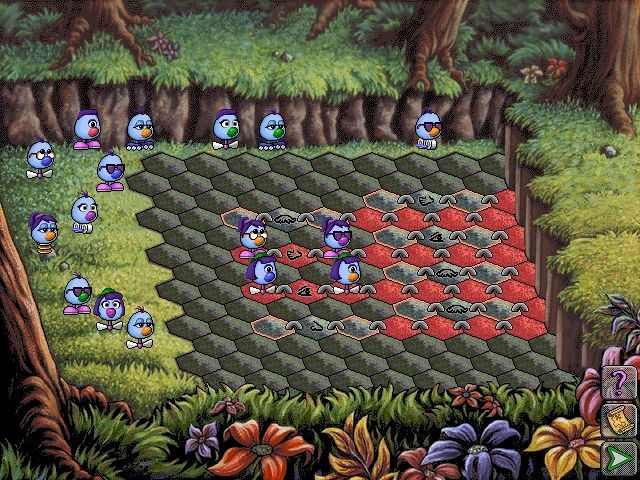
Each is meant to teach some kind of mathematical concept, but the educational aspect is so subtle that it's barely noticeable and the different concepts just result in extremely unique and interesting puzzles. They start out easy, but by the end they become very difficult by any standards - even though it is a game aimed at kids. The puzzles in the game are also extremely engaging. Although the graphics aren't very advanced, since the backgrounds are just scanned in from paintings, and the characters are animated so colorfully that there isn't much lost There is a narrator who delivers bad puns and cheesy lines every time you finish a puzzle or get to a new one. The story is formatted similarly: the main characters have to overcome colorful episodic challenges. There are beautifully illustrated backgrounds that look like they come directly from a children's book. The entire game's aesthetic and story resemble a picture book. On your way to Zoombiniville you encounter all kinds of colorful characters and challenges to face with the help of logic - from a set of tree stumps demanding the right kind of pizza to two cliff faces who will sneeze if the wrong type of Zoombini tries to cross the bridge above them. It's a logic puzzle game where you guide a team of small, blue, pea-shaped creatures called Zoombinis, from the island of their origin, where their people have been enslaved by the merciless bloats, to their new home of Zoombiniville!

The first is Zoombinis, a Logical Journey, the greatest educational game of all time. There are also incredibly difficult challenge areas that create lots of extra gameplay for people who are especially good at the game (or have an especially large amount of time to kill). There are also frequent puzzles between the action segments that help break up the game but aren't especially challenging. The level design is slightly repetitive at times but overall, each of the different worlds has very different enemies and mechanics that keep the game interesting. Another thing that contributes to this is that there is a good amount of grinding while backtracking and to get gold, experience, and items for quests and other things in addition to the fact that you can get enough consumables that you are rarely ever really in danger of dying. The downside to this combat system is that on easier difficulties, it can get slightly boring because mashing buttons will be good enough to win, and on harder difficulties, the combat is too imprecise to beat enemies consistently feeling good. The combination of the crazy projectiles flying around the screen wreaking havoc and the powerful sword combos you can achieve make the player feel as awesome as possible with minimum effort. You're companion fidget can shoot small weak projectiles which you can convert into powerful homing attacks which, depending on what type of projectile you have selected, can explode into giant columns of fire or strike your enemies with massive amounts of chain lightning. The process of balancing these numbers is just as hard and just as important in both types of games.ĭust is a 2D action game where you string together different moves to destroy large crowds of enemies. Additionally, the relationship between them can't stay the same for the entire game or it would be boring.



Both have to keep these numbers close enough to each other that the game is possible to beat, but far enough away that it's interesting. Bejeweled balances the number of points you need to advance to the next level with the number of points you get by making matches - effectively the same things. RPGs have to balance the health of enemies with the attack damage of the player. RPGs function a lot like Bejeweled in this way. A lot of work goes into finding the balance between player power and game difficulty whether it be in a comparatively simple puzzle game like bejeweled or any other type of game, like RPGs or action games. That was my experience playing Bejeweled before I watched this video, but afterwards, I saw that it's difficult to tune a puzzle game like Bejeweled to feel both challenging and fair. You never notice that these numbers are precisely engineered to keep the game engaging as you advance. You never see the finely tuned numbers determining the ends of levels and how many points you get per match. When playing the game as a player, the inner workings of the game's interest curve go over your head. I played Bejeweled while watching the Extra-Credits video on it.


 0 kommentar(er)
0 kommentar(er)
